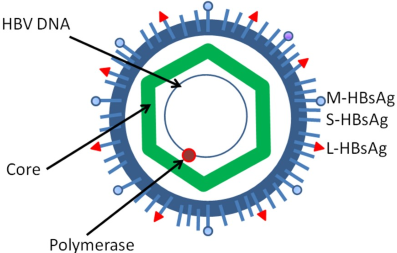
Hepatitis B virus
Hepatitis B is a vaccine-preventable liver infection caused by the hepatitis B virus (HBV). Hepatitis B is spread when blood, semen, or other body fluids from a person infected with the virus enters the body of someone who is not infected. This can happen through sexual contact; sharing needles, syringes, or other drug-injection equipment; or from mother to baby at birth. Not all people newly infected with HBV have symptoms, but for those that do, symptoms can include fatigue, poor appetite, stomach pain, nausea, and jaundice. For many people, hepatitis B is a short-term illness. For others, it can become a long-term, chronic infection that can lead to serious, even life-threatening health issues like cirrhosis or liver cancer. Risk for chronic infection is related to age at infection: about 90% of infants with hepatitis B go on to develop chronic infection, whereas only 2%–6% of people who get hepatitis B as adults become chronically infected. The best way to prevent hepatitis B is to get vaccinated.
Protein P(P03156)
Function
Multifunctional enzyme that converts the viral RNA genome into dsDNA in viral cytoplasmic capsids. This enzyme displays a DNA polymerase activity that can copy either DNA or RNA templates, and a ribonuclease H (RNase H) activity that cleaves the RNA strand of RNA-DNA heteroduplexes in a partially processive 3'- to 5'-endonucleasic mode. Neo-synthesized pregenomic RNA (pgRNA) are encapsidated together with the P protein, and reverse-transcribed inside the nucleocapsid. Initiation of reverse-transcription occurs first by binding the epsilon loop on the pgRNA genome, and is initiated by protein priming, thereby the 5'-end of (-)DNA is covalently linked to P protein. Partial (+)DNA is synthesized from the (-)DNA template and generates the relaxed circular DNA (RC-DNA) genome. After budding and infection, the RC-DNA migrates in the nucleus, and is converted into a plasmid-like covalently closed circular DNA (cccDNA). The activity of P protein does not seem to be necessary for cccDNA generation, and is presumably released from (+)DNA by host nuclear DNA repair machinery.
External core antigen (P0C573 )
Function
May regulate immune response to the intracellular capsid in acting as a T-cell tolerogen, by having an immunoregulatory effect which prevents destruction of infected cells by cytotoxic T-cells. This immune regulation may predispose to chronicity during perinatal infections and prevent severe liver injury during adult infections.
Function
The large envelope protein exists in two topological conformations, one which is termed 'external' or Le-HBsAg and the other 'internal' or Li-HBsAg. In its external conformation the protein attaches the virus to cell receptors and thereby initiating infection. This interaction determines the species specificity and liver tropism. This attachment induces virion internalization predominantly through caveolin-mediated endocytosis. The large envelope protein also assures fusion between virion membrane and endosomal membrane. In its internal conformation the protein plays a role in virion morphogenesis and mediates the contact with the nucleocapsid like a matrix protein.
Multifunctional protein that plays a role in silencing host antiviral defenses and promoting viral transcription. Does not seem to be essential for HBV infection. May be directly involved in development of cirrhosis and liver cancer (hepatocellular carcinoma). Most of cytosolic activities involve modulation of cytosolic calcium. The effect on apoptosis is controversial depending on the cell types in which the studies have been conducted. May induce apoptosis by localizing in mitochondria and causing loss of mitochondrial membrane potential. May also modulate apoptosis by binding host CFLAR, a key regulator of the death-inducing signaling complex (DISC). Promotes viral transcription by using the host E3 ubiquitin ligase DDB1 to target the SMC5-SMC6 complex to proteasomal degradation. This host complex would otherwise bind to viral episomal DNA, and prevents its transcription. Moderately stimulates transcription of many different viral and cellular transcription elements. Promoters and enhancers stimulated by HBx contain DNA binding sites for NF-kappa-B, AP-1, AP-2, c-EBP, ATF/CREB, or the calcium-activated factor NF-AT.
Function
Self assembles to form an icosahedral capsid. Most capsids appear to be large particles with an icosahedral symmetry of T=4 and consist of 240 copies of capsid protein, though a fraction forms smaller T=3 particles consisting of 180 capsid proteins. Entering capsids are transported along microtubules to the nucleus. Phosphorylation of the capsid is thought to induce exposure of nuclear localization signal in the C-terminal portion of the capsid protein that allows binding to the nuclear pore complex via the importin (karyopherin-) alpha and beta. Capsids are imported in intact form through the nuclear pore into the nuclear basket, where it probably binds NUP153. Only capsids that contain the mature viral genome can release the viral DNA and capsid protein into the nucleoplasm. Immature capsids get stuck in the basket. Capsids encapsulate the pre-genomic RNA and the P protein. Pre-genomic RNA is reverse-transcribed into DNA while the capsid is still in the cytoplasm. The capsid can then either be directed to the nucleus, providing more genomes for transcription, or bud through the endoplasmic reticulum to provide new virions.
Host species: Human
Isotype: IgG1, kappa
Applications: Research Grade Biosimilar
Expression system: Mammalian Cells
Host species: Human
Isotype: IgG1-kappa
Applications: Research Grade Biosimilar
Expression system: Mammalian cells
Host species: Rabbit
Isotype: IgG
Applications: ELISA, IHC, WB
Accession: BAA04920.1
Applications: ELISA, Immunogen, SDS-PAGE, WB, Bioactivity testing in progress
Expression system: E. coli
Accession: Q67926
Protein length: Met1-Arg253
Host species: Human
Isotype: IgG1-lambda2
Applications: Research Grade Biosimilar
Expression system: Mammalian Cells
Host species: Mouse
Isotype: IgG1, kappa
Applications: ELISA
Accession: P03138
Host species: Human
Isotype: IgG1-lambda
Applications: Research Grade Biosimilar
Expression system: Mammalian Cells